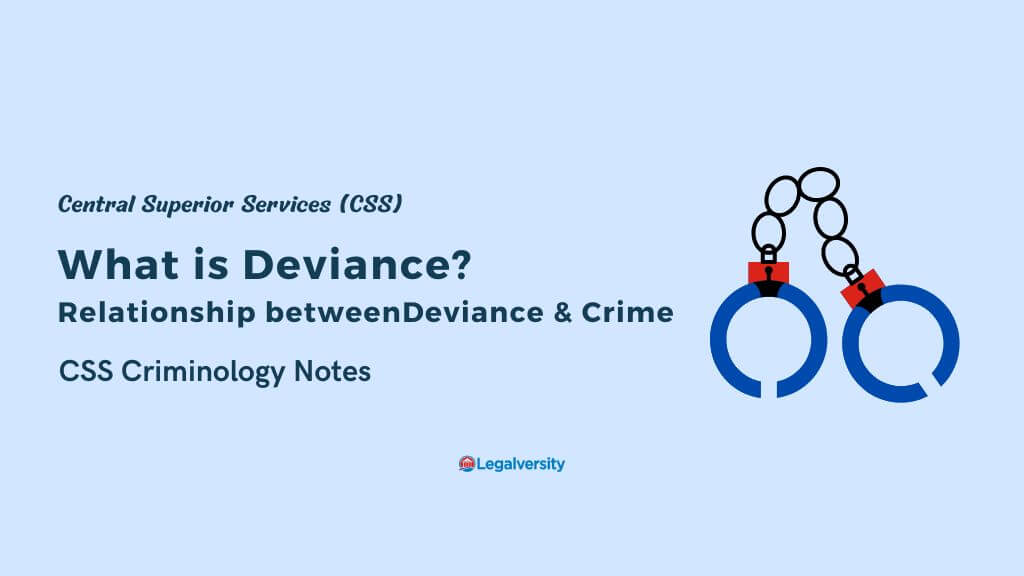What is Deviance?
Deviance is any behavior that violates social norms and is usually of sufficient severity to warrant disapproval from the majority of society. Deviance can be criminal or non-criminal. People who engage in deviant behavior are referred to as deviants. The concept of deviance is complex because norms vary considerably across groups, times, and places. In other words, what one group may consider acceptable, another may consider deviant.
Here, you will learn about what is Deviance and the relationship between Deviance and Crime.
How Deviance is Defined?
Deviance is defined by its social context. To understand why some acts are deviant and some are not, it is necessary to understand what the context is, what the existing rules are, and how these rules came to be established. If the rules change, what counts as deviant also changes. As rules and norms vary across cultures and time, it makes sense that notions of deviance also change.
Why Do People Commit Deviance?
Although deviance is normal in this regard, it remains true that some people are more likely than others to commit it. It is also true that some locations within a given society have higher rates of deviance than other locations; for example, U.S. cities have higher rates of violent crime than do rural areas.
Still, Durkheim’s monastery example raises an important point about the relativity of deviance: whether a behavior is considered deviant depends on the circumstances in which the behavior occurs and not on the behavior itself. Although talking might be considered deviant in a monastery, it would certainly be considered very normal elsewhere.
If an assailant, say a young male, murders someone, he faces arrest, prosecution, and, in many states, possible execution. Yet if a soldier kills someone in wartime, he may be considered a hero. Killing occurs in either situation, but the context and reasons for the killing determine whether the killer is punished or given a medal.
Relationship between Deviance and Crime
What is the relationship between deviance and crime? According to sociologist William Graham Sumner, deviance is a violation of established contextual, cultural, or social norms, whether folkways, mores or codified law.
Codified laws are norms that are specified in explicit codes and enforced by government bodies. A crime is therefore an act of deviance that breaks not only a norm but a law. Deviance can be as minor as picking one’s nose in public or as major as committing murder.
To a large extent, criminology and studies of deviance have developed along separate tracks although they show much overlap. Criminologists have typically limited themselves to issues about legality, crime, or crime-related phenomena.
There are two main intellectual barriers to merging criminology with studies of deviance.
FIRST, some criminal behavior in some places (such as gambling) is not deviant, at least by most definitions of deviance, so would be subject to criminological study but not to study by students of deviance.
SECOND, A second intellectual obstacle to conceiving crime and deviance as one subject matter hinges on disagreements about the nature of human behavior. Some criminologists and some students of deviance contend that all forms of behavior, including specific acts or types of crime or deviance, are more or less distinct, requiring unique explanations.
Vice, Sin, and Evil
Vice
Vice refers to the activities that are made illegal because they offend the moral
standards of the community banning them. In plain words, vice is simply a violation of morality. A vice is a moral failing or a bad habit.
Sin
A sin is an act or behavior that is against religion or God’s will. Crime: Crime is an action against the law. Sin: It is recognized by God or religion. Crime: It is recognized by the state or government.
Evil
Evil, in a general sense, is the opposite or absence of good. Evil can denote profound
immorality, but typically not without some basis in the understanding of the human condition, where strife and suffering are the true roots of evil.
Evil in the broad sense, which includes all-natural and moral evils, tends to be the sort of evil referenced in theological contexts, such as in discussions of the problem of evil.
Norms and Values
Values are general guidelines, while norms are specific guidelines. Values are general
standards, which decide what is good and what is bad. Norms are rules and expectations that specify how people should and should not behave in various social situations.
Both terms norms and values are at many times used interchangeably in our day-to-day discourse. But social scientists use them in a specific sense. Values are general guidelines, while norms are specific guidelines. Norms link values with actual norms.
To conform to a particular value of a society, there can be many norms. Norms link
values with actual norms.
Though there is a difference between norms and values, still, there is often a direct
relationship between values, norms, and sanctions of society. For example, if a society highly values the institution of marriage, it may have norms and strict sanctions which prohibit the act of adultery and allow divorce only in hard cases.
See these as well:

